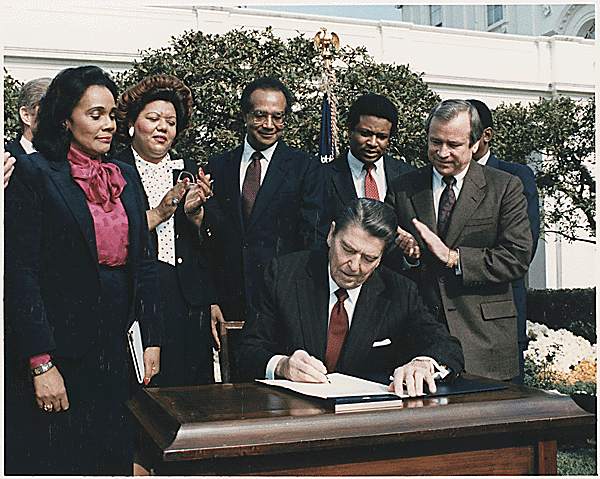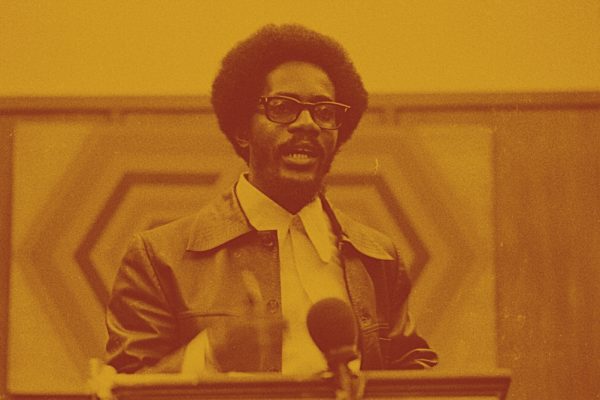On Martin Luther King, Jr., Day in 2016, then–presidential candidate Donald Trump gave a stump speech at the arch-conservative Liberty University in Lynchburg, Virginia. Ostensibly invited to join in Liberty’s celebration of King, Trump made only a singular reference to the civil rights icon, to whom he credited the event’s record-breaking attendance. Trump then launching into his standard repertoire of self-congratulatory bloviation, which he followed with a presentation of a number of policy positions inconsistent with King’s work, including a bigger military, a stronger Second Amendment, and special civil rights for Christians.
Reagan, who thought little of King, ultimately used the creation of a national holiday honoring King as a way to coopt his legacy.
Though alluring, it would be folly to argue that Trump has uniquely debased or elided the ideas, values, and teachings of King. As the history of the federal MLK Day holiday demonstrates, the destruction of King’s legacy and the reframing of King’s words to serve the interests of civil rights opponents began over three decades ago. In fact, Trump’s election represents one logical endpoint of the tactic exemplified by MLK Day itself, legislated under the Reagan administration as part of a strategy to defang King of his most radical qualities while coopting him into the ideology of colorblindness.
The inaccurate conflation of King’s activism with the ideology of colorblindness—in which ignoring race is positioned as the only way to end racism—began in earnest during the Reagan administration. Reagan, who thought little of King, ultimately used the creation of a national holiday honoring King as a way to coopt his legacy, enabling Reagan ironically to oppose key civil rights laws in the name of aligning himself with King’s supposedly colorblind dream. In so doing, Reagan became one of the most successful proselytes of what sociologist Eduardo Bonilla-Silva terms “colorblind racism,” and Reagan’s frequent citation of King marked the beatification of King not as a champion of racial justice but of colorblind ideology.
While campaigning for Jimmy Carter on the eve of the 1980 presidential election, King’s widow Coretta Scott King said she was “scared that if Ronald Reagan gets into office, we are going to see more of the Ku Klux Klan and a resurgence of the Nazi Party.” King’s trepidation was not unwarranted. Reagan built his political career on a foundation of anti-black civil rights. He opposed the Civil Rights Act in 1964, calling it “a bad piece of legislation.” A year later he came out against the Voting Rights Act, which he deemed “humiliating to the South.” During his 1966 California gubernatorial campaign, he defended the Golden State’s Proposition 14, which passed in 1964 and nullified the state’s fair housing law, effectively reinstating the right to discriminate in home sales and leases. “If an individual wants to discriminate against Negroes or others in selling or renting his house,” Reagan insisted, “it is his right to do so.” A Reagan campaign ad that same year referred to black neighborhoods as “jungles.”
Reagan never really believed King deserved a federal holiday, and the establishment of the memorialization was on its surface a hard-won victory for King’s supporters. Civil rights leaders faced immense opposition from both congress and the president in the years leading up to its passing. In October of 1983, for example, when the bill reached the senate floor, North Carolina senator Jesse Helms filibustered it, condemning King’s “calculated use of nonviolence as a provocative act,” and insisting he was a communist.
Reagan positioned himself as the inheritor of King’s “dream” in order to advance the anti-black crusade he had waged since the 1960s.
As support for the holiday gained momentum in 1981 and 1982, Reagan vehemently opposed the idea, arguing that such a tribute would cost the federal government too much money (an estimated $18 million per year) and that “we could have an awful lot of holidays if we start down that road.” On October 19, 1983, Reagan attended his bimonthly President’s News Conference in the East Room of the White House. Shortly after he took to the podium he fielded a question on King. “Mr. President,” a reporter asked, “Senator Helms has been saying on the Senate floor that Martin Luther King, Jr., had communist associations, was a communist sympathizer. Do you agree?” With no discernable pause Reagan responded, “We’ll know in about thirty-five years, won’t we?”, referring to when King’s FBI file would be unsealed.
However, in a dramatic about-face, Reagan capitulated in the final months of 1983. The month following his news conference—and fifteen years after Michigan congressman John Conyers first introduced legislation for the King observance—Reagan sat on the White House lawn and signed a bill establishing a federal holiday for a man he had spent the previous two decades opposing, whilst several hundred attendees sang “We Shall Overcome.”
Yet even after he publicly changed his position, Reagan wrote a letter of apology to Meldrim Thomson, Jr., the Republican governor of New Hampshire, who had begged the president not to support the holiday. His new position, Reagan explained in the letter, was based “on an image [of King], not reality.” Reagan’s support for the federal King holiday, in other words, had nothing to do with his personal views of the civil rights leader. Instead the holiday provided Reagan with political pretext to silence the mounting criticism of his positions on civil rights. By 1983 Reagan faced an onslaught of criticism from groups such as the NAACP and the Urban League for his aggressive assaults on affirmative action and court-ordered busing. With a reelection bid on the horizon, he began to make more concerted efforts to pacify his critics and soften public opinion over his open hostility to civil rights. The King holiday was the primary component of this effort.
Reagan’s pivot on the King holiday provided a two-pronged benefit. On the one hand it would pacify critics of his positions on civil rights, but on the other it enabled Reagan to position himself as the inheritor of King’s colorblind “dream”—a society in which “all men are created equal” and should be judged “not . . . by the color of their skin, but by the content of their character”—in order to advance the anti-black crusade he had waged since the 1960s, now under the alluring mantle of colorblindness.
The notion of a “colorblind” approach to U.S. law originated in 1896, when Justice John Marshall Harlan argued in his dissent to the Plessy v. Ferguson decision—which established the legal precedent for racial segregation—that “separate but equal” was unconstitutional because “our Constitution is color-blind and neither knows nor tolerates classes among citizens.” Nearly sixty years later, Justice Harlan was vindicated when the Warren Court invalidated Plessy in the landmark Brown v. Board of Education (1954). Yet Harlan and Reagan understood colorblindness in profoundly different ways. For Harlan, colorblind law safeguarded non-whites from the institutionalization of white supremacy in state and local governments under Jim Crow. For Reagan, who opposed both the Civil Rights Act and the Voting Rights Act, colorblindness offered an effective ideology through which to roll back the victories of the civil rights movement.
Reagan’s efforts to align himself as the inheritor of King’s colorblind “Dream” picked up considerably during his second term in the White House. Reagan’s assistant attorney general for civil rights, William Bradford Reynolds, began defending the president’s opposition to civil rights programs by insisting that Reagan’s actions were informed by King’s colorblind philosophy. Throughout his second term, Reagan would frequently turn to the colorblind rhetoric, and only the colorblind rhetoric, of the civil rights movement to justify his continued assault on civil rights as a realization of King’s dream.
The most revealing example of Reagan’s second-term King strategy occurred on January 17, 1986. Three days before the inaugural Martin Luther King, Jr., Day, Coretta Scott King unveiled a three-foot solid bronze bust of her slain husband in the Capitol rotunda (later moved to Statuary Hall). After the ceremony Reagan met with King and other civil rights leaders and urged them to “never, never abandon the dream” of a colorblind United States. Reagan’s rendering of King begins and ends on the steps of the Lincoln Memorial. It is a King who said little more than a single sentence: “I have a dream that my four little children will one day live in a nation where they will not be judged by the color of their skin but by the content of their character.” Absent entirely from Reagan’s representations of King are his critiques of capitalism, the war in Vietnam, nuclear weapons, or white supremacy.
As a public figure of white memorialization, King has become the de facto patron saint of colorblind ideology, historical memory and radical political critique be damned.
Ultimately Reagan’s rendition of King as committed, first and foremost, to a colorblind society and therefore opposed to any and all race-conscious remedies to racial injustice—a framework that Trump seems to have adopted—has proven essential to the rising influence of colorblind ideology. As a public figure of official and white memorialization, King has become the de facto patron saint of colorblind ideology, his historical memory and his radical political critique be damned.
In 1988 over fifty thousand people gathered at the Lincoln Memorial to commemorate the twenty-fifth anniversary of the March on Washington. The mood was somber as attendees lamented the two decades of retreat from the civil rights victories of the 1960s. Civil rights activist Elena Rocha remarked, “If Martin Luther King could get up from the grave he would see that he’d have to start all over again raising hell.” As Donald Trump assumes the office of the president of the United States, such a declaration sadly rings even more true today. If we are ever to celebrate King’s legacy in a manner befitting his radical politics, we must cleave our understanding of King from notions of colorblindness. Colorblindness and racial justice are not synonymous. King understood that; so should we.








